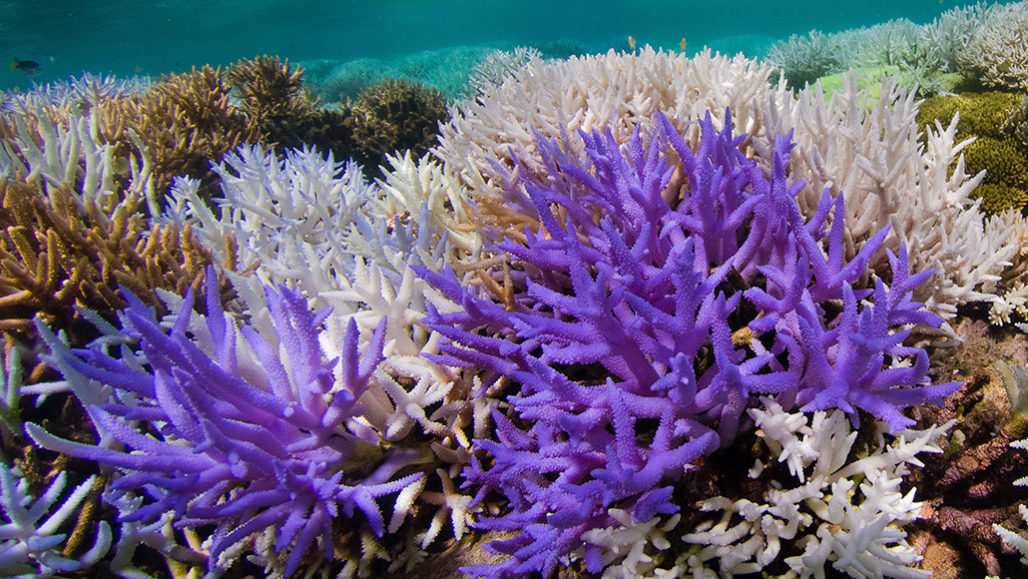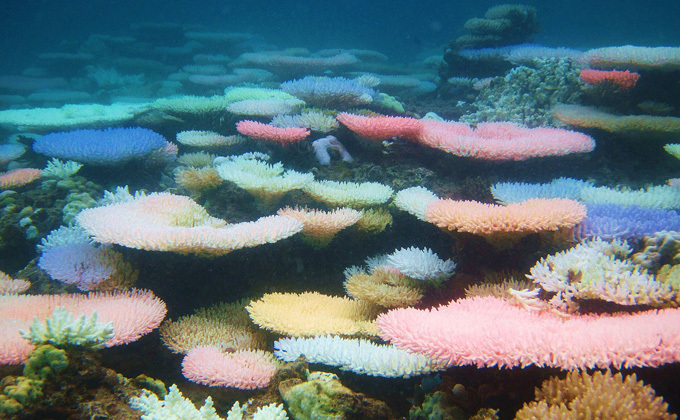Going bright may help corals recover from bleaching
Coral pigments act as a sunscreen and may make a friendlier home for returning algae

In 2016, these Acropora corals in New Caledonia turned a shocking purple after experiencing higher-than-usual temperatures. This colorful response may help corals recover from bleaching.
Richard Vevers/The Ocean Agency, XL Catlin Seaview Survey
Share this:
- Share via email (Opens in new window) Email
- Click to share on Facebook (Opens in new window) Facebook
- Click to share on X (Opens in new window) X
- Click to share on Pinterest (Opens in new window) Pinterest
- Click to share on Reddit (Opens in new window) Reddit
- Share to Google Classroom (Opens in new window) Google Classroom
- Click to print (Opens in new window) Print
For some corals, going bright may be part of their fight against bleaching.
Beneficial algae normally dwell within the cells of most reef-building corals. These algae help feed the corals and give them their color. But higher-than-normal ocean temperatures can cause some corals to bleach. This means they lose those helpful algae. Affected corals can become bone white and may struggle to survive. But when they bleach, some corals turn neon hues from red to blue to purple.
Those flashy colors may help corals win back their lost algal partners, a new study finds. And this can help the corals recover from bleaching, it says.
“It’s visually very striking, but … there was surprisingly little information” on how and why colorful bleaching happens, says Elena Bollati. She’s a marine biologist at the National University of Singapore. She was on the research team, taking part while at the University of Southampton in England.
Some researchers suspected that with the algae gone, the natural colors of bleached corals shone through. The new work suggests something different. Some wavelengths of light appear to trigger the corals to make more of certain pigments. These may act as a sunscreen and create a more comfortable home for the returning algae. Bollati and her colleagues shared their findings May 21 in Current Biology.
The research “shows that some of these corals are trying to protect themselves with really spectacular side effects,” says Daniel Wangpraseurt. He was not involved with the study. A coral reef scientist, he works in England at the University of Cambridge.

Like tanning for corals
The scientists examined bleaching events in ocean corals between 2010 and 2019. They were able to link neon colors to corals experiencing mild heat stress. Such stress happens during a long spell of overly warm water or a brief spike in temperatures. In most cases, the colors appeared two to three weeks after the stress events, Bollati says.
Her team turned to experiments to show what conditions can cause “colorful bleaching.”
In the lab, the scientists exposed corals to a slow ramp up in temperature. As the team turned up the heat, the amount of algae nosedived. This simulated mild bleaching.
They also watch for a red-colored light the algae emit when lit with certain wavelengths. A few weeks after the heat stress, this red fluorescence jumped. The team also monitored fluorescence from the coral itself. That light is caused by the pigment that gives the corals color. The scientists also showed that an imbalance of certain nutrients could trigger colorful bleaching.
Healthy, unbleached corals rely on their algae, known as zooxanthellae (Zoh-zan-THELL-ay) to absorb some sunlight. They use some of this light for photosynthesis to make food for the coral. This also helps screen the corals from some of that sunlight. After losing those algae, the corals face exposure to more sunlight. That light — including its blue wavelengths — can enter and bounce around inside the corals’ skeleton. Those reflections boost the coral tissue’s exposure to the blue light. And that prompted the bleached corals to pump out more pigments, the researchers found.
“It’s like a person tanning,” Bollati says. “The more blue light they get, the more of these pigments they make.” Like the pigments that color skin, coral pigments are protective. They act like a sunscreen. By bumping up pigment production, the corals may be making a friendlier home for returning algae. The team also observed that vividly colored areas of the corals more quickly regained their algae than did areas with less pigment.
Corals “have this capacity to fight back,” says Jörg Wiedenmann. He’s a biologist at the University of Southampton who took part in this new research. Corals “are by no means doomed” after one bleaching event. But, he cautions, their long-term survival depends on people acting to limit climate change. That way corals won’t experience more stress than they can handle.







